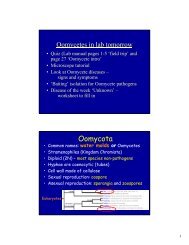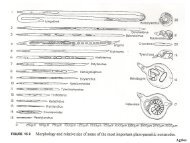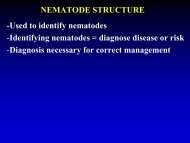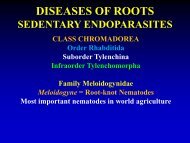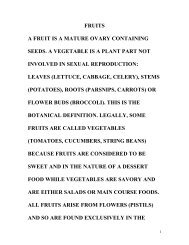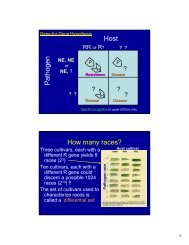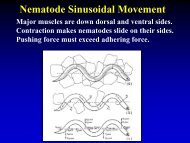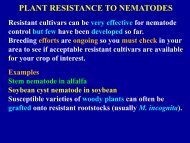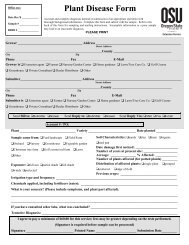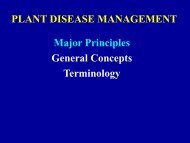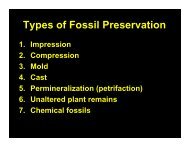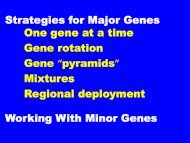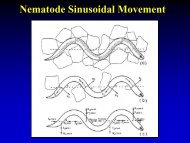Origin of Land Plants (Embryophytes)
Origin of Land Plants (Embryophytes)
Origin of Land Plants (Embryophytes)
You also want an ePaper? Increase the reach of your titles
YUMPU automatically turns print PDFs into web optimized ePapers that Google loves.
<strong>Origin</strong> <strong>of</strong> <strong>Land</strong> <strong>Plants</strong> (<strong>Embryophytes</strong>)<br />
Why?<br />
Ancestors=Green algae=Chlorophyta<br />
Chlorophyll a & b-used in photosynthesis<br />
Carotenoids & xanthophylls-accessory pigments<br />
Starch (stored carbohydrate) in chloroplasts<br />
Cellulose cell walls<br />
Oogamy<br />
Phragmoplast<br />
Cell plate<br />
Alternation <strong>of</strong> generations life cycle – sporophyte &<br />
gametophyte<br />
Green algae very diverse unicells, colonies<br />
spherical balls <strong>of</strong> cells, coencytic filaments, 2D &<br />
3D branched forms,
Which group <strong>of</strong> green algae is the<br />
closest to land plant origins?<br />
Class: Charophyceae<br />
Order: Coleochaetales<br />
Family: Coleochaetaceae<br />
Genus: Coleochaete<br />
cell plate<br />
phragmoplast<br />
plasmodesmata (multicellular growth)<br />
lignin-like compounds (found in secondary wall<br />
thickenings in vascular plants)<br />
sporopollenin (found in pollen & spores <strong>of</strong> vascular<br />
plants)<br />
suberin-like compounds (found in casparian strip <strong>of</strong><br />
endodermis in vascular plants and in bark (phellem)
Cooksonia<br />
Upper Silurian –earliest vascular plant
Cooksonia sprg<br />
Dianne Edwards, UK<br />
Cooksonia tracheid
Tetrads <strong>of</strong> four spores<br />
Products <strong>of</strong> meiosis
Brochotriletes<br />
Sporae<br />
Dispersae<br />
Genera<br />
From<br />
Rhynie<br />
Chert<br />
Apiculiretusispora<br />
Emphanisporites<br />
Dictyotriletes
Upper Silurian landscape-Cooksonia
Dawson 1859<br />
Described early land plants from the Lower<br />
Devonian <strong>of</strong> New Brunswick and Quebec-<br />
Gaspé Bay-compression/impressions<br />
Dichotomizing axes, some with spine-like<br />
projections, sprg<br />
Ignored until 1917 Kidston and Lang started<br />
to publish on the plants from the Rhynie<br />
Chert
Rhynia gwynne-vaughanii<br />
Vascular plants in the<br />
Rhynie Chert
Rhynia gwynne-vaughanii
Rhynia gwynne-vaughanii<br />
Stomatal apparatus<br />
Ridged cuticle surface<br />
Epidermal cells
Rhynia gwynne-vaughanii<br />
Tracheids with annular secondary wall thickenings<br />
Sporangium with abscission zone
Rhynia<br />
gwynne-vaughanii<br />
Sporangia
Rhynia gwynne-vaughanii<br />
Growth habit<br />
Rhizoids on hemispherical projections<br />
New reconstruction<br />
Sporangia shed<br />
Plant branches below sprg
Rhynie Chert landscape reconstruction
Vascular plants described by<br />
Kidston and Lang<br />
1. Rhynia gwynne-vaughanii<br />
2. *(=Rhynia major) now Aglaophyton major<br />
3. Asteroxylon mackiei<br />
(note part <strong>of</strong> this plant is now Nothia)<br />
4. *Hornea lignieri now Horneophyton lignieri<br />
now<br />
5. *Nothia aphylla El Sadadawy & Lacey 1979<br />
(Lyon 1964 recognized problem)<br />
6. Trichopherophyton teuchansii Lyon &<br />
Edwards 1991<br />
7. Ventarura lyonii Powell et al. 2000
Aglaophyton major x.s.<br />
Now not considered to be a vascular plant
Asteroxylon mackiei<br />
Now considered to be a lycopod – a vascular plant
Horneophyton lignieri<br />
Now not considered to be a vascular plant
What Dawson found<br />
• Axes with terminal sporangia<br />
• Some spiny<br />
• Some with smooth surfaces<br />
• Several types
Early land plants<br />
Classification by Harlan Banks, 1968<br />
Division: Tracheophyta<br />
Subdivision: Rhyniophytina<br />
Subdivision: Zosterophyllophytina<br />
Subdivision: Trimerophytina<br />
Subdivision: Psilotophytina<br />
Psilotum and Tmesipteris
Harlan Banks
Subdivision: Rhyniophytina<br />
• Oldest known vascular plants – U. Silurian<br />
• E.g., Cooksonia, Rhynia<br />
• No roots<br />
• No leaves<br />
• Naked axes (green and photosynthetic)<br />
• Dichotomous branching<br />
• Terminal sprg<br />
• Simple, slender protosteles, centrarch<br />
maturation <strong>of</strong> primary xylem<br />
• Small plants – less than 1 m tall - @20 cm
Rhynia gwynne-vaughanii<br />
Growth habit<br />
Rhizoids on hemispherical projections<br />
New reconstruction<br />
Sporangia shed<br />
Plant branches below sprg
Tom Taylor & David Edwards<br />
Fossil fungi & Rhynia reconstructions
<strong>Plants</strong> that used to be in<br />
Rhyniophytina but have been<br />
removed<br />
• Aglaophyton major ( = Rhynia major<br />
Kidston & Lang)<br />
• Horneophyton lignieri Kidston & Lang<br />
• Nothia aphylla El-Saadawy & Lacey<br />
(Lyon 1964 did not provide a diagnosis)<br />
Unfortunately, now not classified<br />
anywhere – called “rhyniophytoid” in<br />
lab manual
Sawdonia
Sawdonia
Zosterophyllum<br />
myretonianum
Subdivision: Zosterophyllophytina<br />
• L. Devonian (or U. Silurian?)<br />
• E.g., Zosterophyllum, Sawdonia, Gosslingia,<br />
Rebuchia (see sheets)<br />
• No leaves<br />
• No roots<br />
• Some naked axes, some with enations<br />
• Dichotomous branching<br />
• Sprg are cauline (on side <strong>of</strong> stem)<br />
• Protosteles circular or elliptical- exarch<br />
• A little more robust than rhyniophytes,<br />
maybe up to 1 m tall<br />
• Sterile and fertile zones on plant<br />
• Evolved from rhyniophytes?- gave rise to<br />
lycopods
Psilophyton crenulatum Doran
Trimerophytina<br />
Trimerophyton<br />
Psilophyton
Subdivision: Trimerophytina<br />
• Middle & Upper Devonian<br />
• E.g., Trimerophyton, Psilophyton, Pertica<br />
• No leaves<br />
• No roots<br />
• Naked axes or enations<br />
• Branching more variable than other grps.<br />
– Dichotomous, trichotomous<br />
• Growth habits- monopodial, pseuomonopodial<br />
• Terminal sprg in pairs<br />
• Sterile & fertile zones<br />
• Protosteles -slender, centrarch<br />
• Larger plants than rhyniophytes<br />
• Thought to have evolved from rhyniophytes and given<br />
rise to the other groups <strong>of</strong> vascular plants
Subdivision: Psilotophytina<br />
• Psilotum<br />
• Tmesipteris<br />
• Extant plants with protosteles<br />
• Enations<br />
• Dichotomous branching<br />
• Green photosynthetic stems<br />
• Synangia (Psilotum 3 sprg, Tmesipteris 2)<br />
• No leaves, no roots<br />
• No fossil record
Aglaophyton<br />
major<br />
(=Rhynia<br />
major)<br />
px=protoxylem, 1 st formed<br />
mx=metaxylem,<br />
formed 2 nd
sporangia
Stomata & rhizoids
Aglaophyton major<br />
reconstruction
Rhyniophytoid plants or<br />
Protracheophytes<br />
Used to be in Rhyniophytina but on<br />
reexamination they have been removed-<br />
Due to studies by Kenrick and Crane 1991<br />
on the conducting cells <strong>of</strong> early land plants<br />
Subsequent work by Friedman & Cook 2000 &<br />
others<br />
3 types<br />
1. No secondary wall thickenings<br />
2. G-type<br />
3. S-type
Discovery <strong>of</strong> Rhynie Chert<br />
gametophytes<br />
Changed our ideas about early land<br />
plants<br />
Remy & Remy 1980’s onward-believed<br />
Three types <strong>of</strong> gametophytes found, now<br />
several more are known<br />
Both permineralized and<br />
compression/impression gametophytes<br />
now known
Aglaophyton conducting cells<br />
No secondary wall thickenings<br />
Like the hydroids & leptoids<br />
<strong>of</strong> mosses<br />
Bubble-like<br />
structures in<br />
some cells-<br />
Probably<br />
taphonomic
Aglaophyton<br />
major<br />
(=Rhynia<br />
major)<br />
Px = hydroids<br />
Mx = leptoids
Lyonophyton – gametophyte <strong>of</strong> Aglaophyton
Lyonophyton antheridium with sperm
Lyonophyton –<br />
gametophyte <strong>of</strong> Aglaophyton
Horneophyton
Horneophyton rhizoids
Horneophyton<br />
Plant base & rhizoids
Horneophyton sporangia & spores
Horneophyton sprg<br />
with columella &<br />
spores
Anthoceros<br />
A hornwort<br />
(bryophyte)<br />
sporophyte<br />
gametophyte<br />
Sporangium (capsule) has a columella
Horneophyton stoma and conducting cells<br />
Tracheids? Debatable
Langiophyton – gametophyte <strong>of</strong> Horneophyton
Langiophyton with archegonia
Langiophyton<br />
Gametophyte<br />
<strong>of</strong><br />
Horneophyton
Nothia aphylla<br />
A dichotomy<br />
Short and giant cells in epidermis
Nothia rhizoids
Nothia sporangia
Nothia<br />
reconstructions
Nothia reconstruction
Kidstonophyton – gametophyte <strong>of</strong> Nothia
Kidstonophyton<br />
Gametophyte <strong>of</strong><br />
Nothia
How Rhynie Chert gametophytes<br />
assigned to sporophytes<br />
• Epidermal cell morphology<br />
• Conducting cell type<br />
• Stomatal organization<br />
• Presence <strong>of</strong> glands (sunken, Horneophyton)
Compression/<br />
impression<br />
gametophytes<br />
from the<br />
Devonian<br />
Sciadophyton<br />
Calyculiphyton
S-type tracheid<br />
G-type tracheid<br />
S=Sennicaulis<br />
e.g. Rhynia<br />
G=Gosslingia<br />
e.g. Psilophyton<br />
Kenrick & Crane<br />
1991
Rhynie Chert landscape reconstruction



